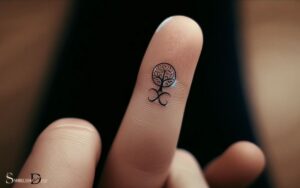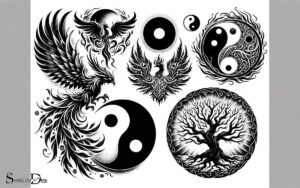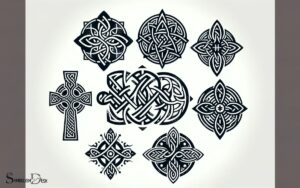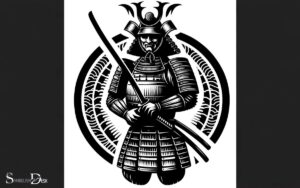What Does a Rainbow Tattoo Symbolize? Hope!
A rainbow tattoo often symbolizes hope, diversity, and the celebration of LGBTQ+ pride. It embodies a broad spectrum of meanings from cultural significance to personal empowerment and spiritual unity.
The rainbow tattoo is a powerful symbol with various interpretations that resonate with different people and communities:
- LGBTQ+ Pride: The rainbow flag is synonymous with LGBTQ+ pride, representing the community’s diversity and the spectrum of sexualities and gender identities.
- Hope and Promise: In many cultures, the rainbow is seen as a sign of hope and new beginnings, often following a storm.
- Diversity and Inclusion: A rainbow’s different colors coming together harmoniously represent the beauty of diversity and the importance of inclusion.
- Spiritual Significance: For some, rainbows symbolize spiritual connection, transformation, or the bridging of earthly and supernatural realms.
Embracing individuality and universal harmony, a rainbow tattoo is a vibrant declaration of one’s values and aspirations.
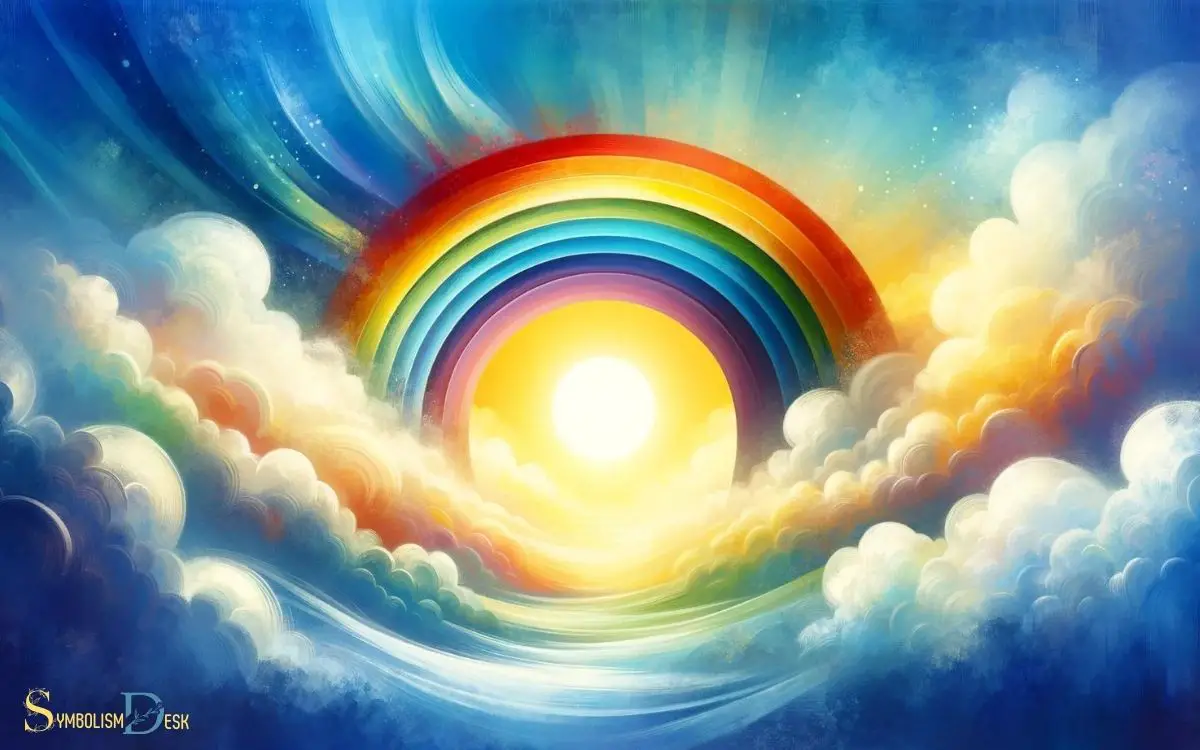
Key Takeaway
Historical Significance
The historical significance of rainbow tattoos dates back to ancient civilizations, symbolizing diverse cultural meanings and representations.
- In many ancient cultures, the rainbow was seen as a bridge between the physical and spiritual worlds, often associated with deities or supernatural beings.
- For instance, in Norse mythology, the rainbow was believed to be a bridge connecting the realm of humans to the realm of the gods.
- In ancient Mayan and Aztec civilizations, the rainbow was associated with deities of fertility and rain.
- Additionally, in many cultures, the rainbow was seen as a symbol of hope, diversity, and harmony.
Over time, the rainbow has continued to hold significance, representing various ideologies such as LGBTQ pride, unity, and inclusivity.
LGBTQ+ Pride Representation
The rainbow has long been recognized as a symbol of LGBTQ+ pride and inclusivity. It represents the diverse spectrum of identities within the community and the movement towards equality and acceptance.
For many individuals, getting a rainbow tattoo is a powerful way to express their personal identity and show solidarity with the LGBTQ+ community.
Rainbow as LGBTQ + Symbol
Representing LGBTQ+ pride, a rainbow tattoo serves as a powerful symbol of inclusivity and acceptance.
This symbol holds significant meaning for individuals within the LGBTQ+ community and their allies, standing as a visual representation of diversity, equality, and love.
The rainbow flag was first introduced as a symbol of gay pride and LGBTQ+ rights in 1978, and it has since become a widely recognized icon for the community.
The vibrant colors of the rainbow reflect the diversity of the LGBTQ+ community, with each color representing a different aspect of identity and unity.
The symbol also signifies the ongoing struggle for LGBTQ+ rights and the celebration of individuality and self-expression.
Pride and Inclusivity
A rainbow tattoo symbolizes LGBTQ+ pride and inclusivity, serving as a visual representation of diversity, equality, and love. It’s a powerful statement of support for the LGBTQ+ community, signaling acceptance and celebration of all sexual orientations and gender identities.
The rainbow flag, originally designed by artist Gilbert Baker in 1978, has become a widely recognized symbol of pride and inclusivity.
By getting a rainbow tattoo, individuals show solidarity with the LGBTQ+ community, promoting awareness and acceptance. It signifies the belief in a world where everyone can live and love freely, without fear of discrimination or prejudice.
This act of solidarity fosters a sense of belonging and support, creating a more inclusive and accepting society. Transitioning from this, the next section will explore how rainbow tattoos serve as a form of personal expression and identity.
Personal Expression and Identity
LGBTQ+ individuals express their identity and pride through rainbow tattoos, making a bold statement of solidarity and celebration.
These tattoos hold deep personal significance and serve as a form of self-expression and empowerment.
They symbolize the following:
- Visibility: Rainbow tattoos are a visible way for individuals to proudly display their LGBTQ+ identity, signaling to others that they’re part of the community.
- Resilience: For many wearers, the rainbow tattoo represents resilience in the face of adversity and a testament to overcoming societal challenges.
- Belonging: It serves as a powerful symbol of belonging, acceptance, and support within the LGBTQ+ community, offering a sense of unity and shared experiences.
Through these tattoos, individuals communicate their journey, struggles, and triumphs with pride and confidence.
Hope and Resilience
Symbolizing resilience and optimism, a rainbow tattoo represents the attitude of overcoming challenges with unwavering hope. The vibrant colors of the rainbow are often seen as a symbol of positivity and promise after a storm.
For many individuals, the rainbow tattoo serves as a reminder that even in the darkest of times, there’s always a chance for better days ahead. It embodies the idea of resilience, the ability to bounce back from adversity, and the strength to persevere.
By wearing this tattoo, people express their determination to remain hopeful and optimistic in the face of life’s trials.
It’s a visual affirmation of their inner strength and a declaration of their belief in brighter, more colorful tomorrows.
Spiritual and Cultural Meanings
The rainbow tattoo holds significant spiritual and cultural meanings across various global communities.
- Spiritual Significance: In many belief systems, the rainbow is seen as a symbol of hope, promise, and divine intervention. It’s often associated with messages of peace, renewal, and the presence of higher powers.
- Cultural Diversity: Different cultures interpret the rainbow in unique ways, with some seeing it as a bridge between the earthly and spiritual realms, while others view it as a symbol of diversity and inclusivity.
- Historical Representations: Throughout history, the rainbow has been depicted in art, literature, and mythology, representing various spiritual and cultural themes, including creation, transformation, and the interconnectedness of all living beings.
These spiritual and cultural meanings add depth and significance to the choice of a rainbow tattoo, making it a powerful symbol for those who choose to wear it.
Symbol of Unity and Inclusivity
The rainbow tattoo symbolizes unity and inclusivity, representing LGBTQ+ pride and acceptance. It serves as a powerful statement of diversity and the importance of embracing differences.
Additionally, it’s a universal symbol of peace and harmony, promoting the idea of coming together as one.
LGBTQ+ Pride Representation
LGBTQ+ Pride’s rainbow tattoo symbolizes unity and inclusivity, representing the community’s unwavering solidarity.
The tattoo serves as a powerful symbol of love and acceptance, celebrating the diversity and uniqueness of individuals within the LGBTQ+ community.
Here’s why the rainbow tattoo holds such significance:
- Inclusivity: The rainbow tattoo is a visual representation of the LGBTQ+ community’s commitment to inclusivity, welcoming individuals of all sexual orientations and gender identities.
- Unity: It stands as a reminder of the unity and strength found within the community, fostering a sense of belonging and support for one another.
- Visibility: The tattoo provides visibility for LGBTQ+ individuals, serving as a form of self-expression and empowerment, especially for those who may feel marginalized or misunderstood.
Diversity and Acceptance
Representing the LGBTQ+ community’s commitment to diversity and acceptance, the rainbow tattoo exemplifies unity and inclusivity among individuals of all sexual orientations and gender identities.
This symbol promotes a message of support and understanding, fostering a culture of inclusiveness and respect for differences.
The rainbow flag, from which the tattoo draws its inspiration, serves as a powerful visual reminder of the beauty and strength found in diversity. It stands as a unifying symbol, promoting a world where everyone is embraced for who they are.
The rainbow tattoo signifies a safe space, where individuals can feel accepted and valued regardless of their sexual orientation or gender identity. It serves as a beacon of hope, encouraging others to embrace diversity and stand together in solidarity.
Transitioning from this celebration of diversity, the rainbow tattoo also symbolizes peace and harmony.
Peace and Harmony Symbol
Exemplifying unity and inclusivity, the rainbow tattoo symbolizes peace and harmony, serving as a powerful visual reminder of the beauty and strength found in diversity. The vibrant colors of the rainbow tattoo represent the different identities and experiences that make up the human race, coming together in a stunning display of solidarity. Similarly, rose tattoos symbolism also carries a profound message of love and acceptance, representing the universal language of compassion that transcends all barriers. Together, these symbols remind us of the importance of embracing and celebrating our differences, as well as the potential for growth and understanding that comes from doing so.
- Symbol of Unity: The rainbow tattoo represents the coming together of different colors, just as people from different backgrounds come together to form a harmonious society.
- Inclusivity: By embracing all the colors of the rainbow, this tattoo symbolizes the acceptance and celebration of individuals from all walks of life.
- Promotion of Peace and Harmony: The vibrant and varied nature of the rainbow serves as a potent symbol for peaceful coexistence and the celebration of differences.
Rainbow tattoos are a powerful statement of embracing peace, unity, and inclusivity, making them a popular choice for individuals who value diversity and want to promote a harmonious and inclusive society.
Personal Empowerment and Expression
Rainbow tattoos symbolize personal empowerment and expression through vibrant colors and meaningful imagery.
For many individuals, the rainbow holds deep personal significance, representing diversity, inclusivity, and the freedom to be oneself.
The act of getting a rainbow tattoo can be a powerful statement of self-acceptance and pride in one’s identity. It serves as a visible symbol of strength and resilience, particularly for those who’ve faced adversity or discrimination.
The use of bright and bold colors in rainbow tattoos also reflects a desire to stand out and make a positive impact.
By choosing to permanently ink this powerful symbol on their skin, individuals assert their right to live authentically and boldly express themselves, sending a strong message of empowerment and self-expression.
Interpretations in Different Cultures
In different cultures, the symbolism of a rainbow tattoo varies according to diverse interpretations and beliefs.
- Western Culture: In Western societies, the rainbow is often associated with LGBTQ+ pride and support for diversity and inclusivity.
- Native American Culture: Among some Native American tribes, the rainbow symbolizes the bridge between the physical and spiritual worlds, representing harmony and balance.
- Asian Culture: In many Asian cultures, the rainbow is seen as a sign of good luck and fortune, often associated with positive transformations and new beginnings.
Understanding the cultural significance of a rainbow tattoo can provide insight into the rich and varied meanings it holds for different people.
Whether as a symbol of pride, spirituality, or luck, the rainbow tattoo carries deep cultural significance across the globe.
Conclusion
The rainbow tattoo holds a deep and diverse symbolism that extends beyond its vibrant colors. It represents historical significance, LGBTQ+ pride, hope, spirituality, unity, and personal empowerment.
Its various interpretations in different cultures highlight the universal message of inclusivity and resilience.
Whether as a symbol of personal expression or cultural significance, the rainbow tattoo evokes a powerful emotional response, reminding individuals of the beauty in diversity and the strength in unity.

